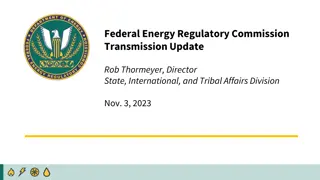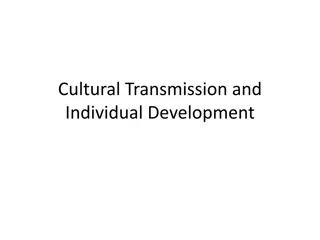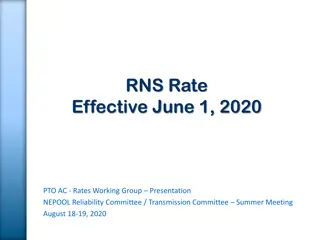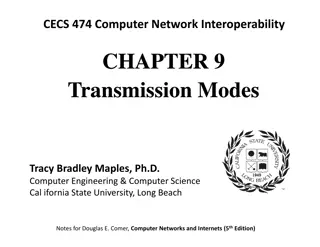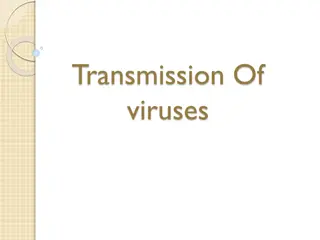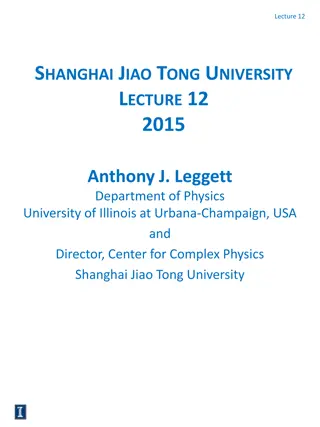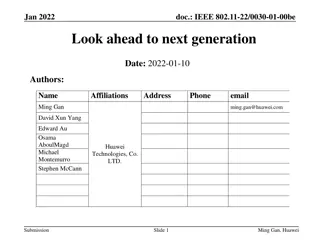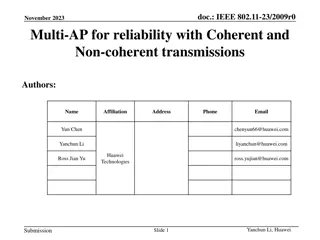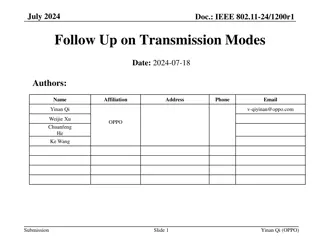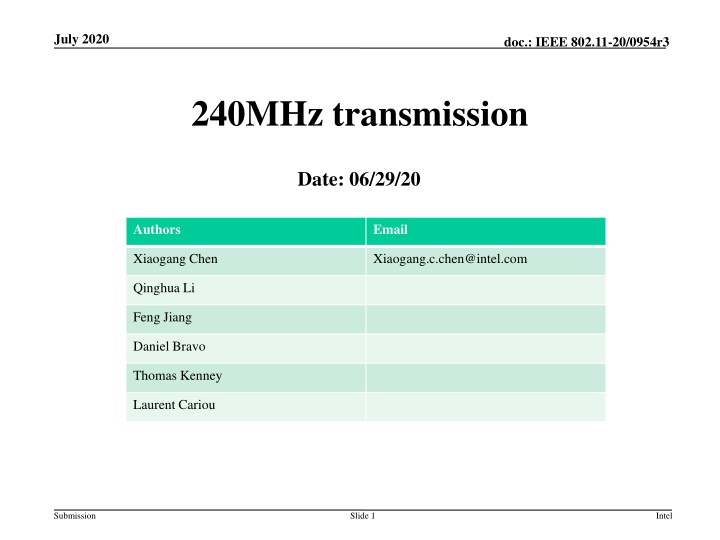
IEEE 802.11-20/0954r3: Considerations on 240MHz Transmission Definition
Explore the debate on defining 240MHz transmission within IEEE 802.11-20/0954r3, analyzing the implications on PPDU types, channelization, and device compatibility. Dive into the complexities and potential benefits of dedicated 240MHz PPDU versus repurposing existing 320MHz schemes. Gain insights into the key considerations for industry stakeholders in evolving wireless standards.
Download Presentation

Please find below an Image/Link to download the presentation.
The content on the website is provided AS IS for your information and personal use only. It may not be sold, licensed, or shared on other websites without obtaining consent from the author. If you encounter any issues during the download, it is possible that the publisher has removed the file from their server.
You are allowed to download the files provided on this website for personal or commercial use, subject to the condition that they are used lawfully. All files are the property of their respective owners.
The content on the website is provided AS IS for your information and personal use only. It may not be sold, licensed, or shared on other websites without obtaining consent from the author.
E N D
Presentation Transcript
July 2020 doc.: IEEE 802.11-20/0954r3 240MHz transmission Date: 06/29/20 Authors Email Xiaogang Chen Xiaogang.c.chen@intel.com Qinghua Li Feng Jiang Daniel Bravo Thomas Kenney Laurent Cariou Submission Slide 1 Intel
July 2020 doc.: IEEE 802.11-20/0954r3 Background Definition of the 240MHz transmission is not clear in the SFD. Dedicated 240MHz PPDU or 320MHz PPDU with 80MHz punctured? Do we need to define 240MHz channel and BSS? Alt.1: Reuse 320MHz PPDU, 320MHz channelization. Alt.2: Define a dedicated 240MHz PPDU, 240MHz channelization. Submission Slide 2 Intel
July 2020 doc.: IEEE 802.11-20/0954r3 Considerations on 240MHz PPDU Very likely there will be no 240MHz only STA. 240MHz STA will reuse the 320MHz baseband processing or even RF; 996*3 RU is already supported in 320MHz PPDU as a punctured mode; The 320MHz receiver should be able to handle the case that an OBSS is in the punctured 80MHz. 240MHz PPDU, even defined, will use the same mask as 320MHz punctured 80MHz; 240MHz PPDU, even defined, is becoming a virtual concept. Define 240MHz PPDU means a new mode with many related sub- topic to discuss and product verifications. E.g. STF/LTF sequence, Tx/Rx requirements, and any BW related issues; But the checkbox is still 320MHz supported in the product. No 240MHz PPDU will simplify the spec and product verification. Submission Slide 3 Intel
July 2020 doc.: IEEE 802.11-20/0954r3 Considerations on 240MHz PPDU Cont d Example: MRUs defined for 240MHz merge to 320MHz PPDU without add any new entry or remove any existing entries. The MRU merging should be the only addendum of not defining 240MHz PPDU. BW RU Mandatory in Non-OFDMA for: AP, STA AP, STA 240 MHz 320 MHz 3 996, 2 996+484, 2 996 (any 2) 4 996, 3 996+484, 3 996 (any 3) BW RU Mandatory in Non-OFDMA for: AP, STA 320 MHz 4 996, 3 996+484, 3 996 (any 3), 2 996+484 (within contiguous 240MHz), 2 996 (within contiguous 240) BW RU Mandatory in OFDMA for: 240 MHz Non-AP STA only 2 996+484 320 MHz Non-AP STA only 3 996+484, 3 996 (any 3) BW RU Mandatory in OFDMA for: 320 MHz Non-AP STA only 3 996+484, 3 996 (any 3), 2 996+484 (within contiguous 240MHz) Submission Slide 4 Intel
July 2020 doc.: IEEE 802.11-20/0954r3 Considerations on 240MHz channel The channelization in [1], if agreed, will cover all the popular cases of 240MHz transmission. All the non-staggered 240MHz in LPI; All the 240MHz in AFC. Any other unique benefit of defining 240MHz channel/BSS instead of use 320MHz BSS? More 240MHz channels than 320MHz channels for flexible deployment? Enterprise deployment prefer smaller BW, e.g. 20/40 instead of >80; Comparing with 320MHz channels, the number of 240MHz channels is also not sufficient for frequency reuse. Submission Slide 5 Intel
July 2020 doc.: IEEE 802.11-20/0954r3 Background of R2 (R2 updates: P6~P13) Concerns of not defining 240MHz PPDU: Signaling: some of the signaling design is based on the assumption that 240MHz transmission is 240MHz PPDU. Number of modes: This contribution increases/decreases the modes we agreed in SFD Different interpretation of 240MHz transmission. E.g. 240MHz transmission and the associated puncturing modes can be present in any 996x3 frequency resource (contiguous/non-contiguous) in 320MHz PPDU. Defining 240MHz PPDU or not doesn t affect these modes. E.g. If defining 240MHz PPDU, there will be only one 240MHz transmission within 320MHz PPDU, which is the one covering the P160. E.g. some interpretation in the middle. But we need to move forward Clean up the modes supported in SFD; Decide if 240MHz PPDU is defined. Submission Slide 6 Intel
July 2020 doc.: IEEE 802.11-20/0954r3 Thoughts on 240MHz transmission (1/2) Agreed: No 240 channelization; 240MHz transmission use 320MHz PPDU mask. No precedence to define a xx BW PPDU without xx BW channel and xx BW mask in WiFi. There were 20/40/80/160MHz PPDU and 20/40/80/160MHz mask. But no 60MHz/100MHz PPDU Based on the passed SP, 240MHz is a virtual concept in 320MHz PPDU already. If defining 240MHz PPDU, it s a duplicated transmission mode with 320MHz with 80MHz punctured. Any modes/MRU supported in 240MHz transmission can be supported in 320MHz PPDU. Submission Slide 7 Intel
July 2020 doc.: IEEE 802.11-20/0954r3 Thoughts on 240MHz transmission (2/2) A new PPDU BW means many changes in spec / product validation. If we don t define 240MHz PPDU we can save the efforts of spec drafting in the following subclause: EHT-SIG: EHT-SIG RU allocation subfield; Frequency mapping Subcarrier and resource allocation RU index; Null tone index; 20MHz operating within larger BW Math equations STF sequence, LTF sequence Pilot index Segment parser Non-HT dup.. Tx/Rx reqirements CCA. Strongly prefer not defining 240MHz PPDU. Submission Slide 8 Intel
July 2020 doc.: IEEE 802.11-20/0954r3 Modes clean up Any modes/MRU supported in 240MHz transmission can be supported in 320MHz PPDU . MRU clarification for 320MHz PPDU (right click to open as excel) Merging MRU defined for 240MHz into 320MHz PPDU. 320MHz PPDU (one cell is 40MHz except 484+242) 996x4 (1 Opts) Table in the SFD: BW 80 MHz 160 MHz 240 MHz 320 MHz RU 484+242 996+484 2 996+484 3 996+484, 3 996 (any 3) Mandatory in OFDMA for: Non-AP STA only Non-AP STA only Non-AP STA only Non-AP STA only Non-OFDMA BW 80 MHz 160 MHz RU 484+242 996+484 996+(484+242) 3 996, 2 996+484, 2 996 (any 2) 4 996, 3 996+484, 3 996 (any 3) Mandatory in Non-OFDMA for: AP, STA AP, STA AP, STA AP, STA AP, STA 996+484 (8 Opts) 240 MHz 320 MHz OFDMA 484+242 (16 Opts) 996x2+484 (12 Opts) OFDMA & Non-OFDMA 996x3+484 (8 Opts) 996x3 (4 Opts) Submission Slide 9 Intel
July 2020 doc.: IEEE 802.11-20/0954r3 MRU defined for 240MHz transmission Which 240MHz transmission is valid in 320MHz? All valid 80MHz x 3? Any MRU defined will be valid for every 240/160+80MHz definition. Too many modes. We avoided this route in 320MHz PPDU. Only the one covers P160? Reduced ~75% of the modes comparing with the one above... In 320Mhz PPDU, propose to only allow puncturing 240-1 and 240-2. Note that 240-1,2,3,4 are allowed as un-punctured (320MHz with 80MHz punctured) 320MHz PPDU 240-1 240-2 240-3 240-4 Submission Slide 10 Intel
July 2020 doc.: IEEE 802.11-20/0954r3 996+484 SP passed to disallow 996+484 straddles two 160MHz channels. 996+484 straddle 80-2 and 80-3 Straddle P160 and S160 is disallowed in 320MHz PPDU but allowed in 240Mhz transmission; The group agree 240MHz transmission will be implemented with 320MHz Tx/Rx chain. Propose to use the rule defined for 320MHz PPDU. 320MHz PPDU 996+484 -1 996+484 -2 996+484 -3 996+484 -4 Submission Slide 11 Intel
July 2020 doc.: IEEE 802.11-20/0954r3 996x2 996x2-1 and 996x2-2 shall not be allowed. Indicated as 160Mhz PPDU. 996x2 only cover S160 is not valid. 996x2-3 SP passed to disallow 996+484 which straddle two 160MHz channels; 996x2-3 is the un-punctured version of 996+484; Propose to disallow under the same spirit. Also propose to disallow the two options 996x2-4,5. 80MHz hole in the middle may be risky depends on the puncturing mask definition. 996x2-3 996x2-4 996x2-5 996x2-1 996x2-2 Submission Slide 12 Intel
July 2020 doc.: IEEE 802.11-20/0954r3 Summary Propose to not define 240MHz PPDU in 11be. Simplify the spec draft; Reduce modes of validation; A better balance between complexity and gain. Submission Slide 13 Intel
July 2020 doc.: IEEE 802.11-20/0954r3 SP1 Do you agree that no 240MHz PPDU is defined in 11be. The 240Mhz transmission is defined as 320MHz PPDU with 80Mhz punctured. The punctured 80MHz is either the left 80MHz or the right 80MHz in the 320MHz PPDU Submission Slide 14 Intel
July 2020 doc.: IEEE 802.11-20/0954r3 SP2a In 320MHz PPDU, do you agree with the options defined below for MRU 996x4, 996x3, 996+484, and 484+242. 320MHz PPDU (one cell is 40MHz except 484+242) 996x4 (1 Opts) 996+484 (8 Opts) 484+242 (16 Opts) One cell is 20MHz 996x3+484 (8 Opts) 996x3 (4 Opts) Submission Slide 15 Intel
July 2020 doc.: IEEE 802.11-20/0954r3 SP2b Do you agree that MRU 996x2 shall not straddle two 160MHz channels? Note: The three options below are now allowed for MRU 996x2. 996x2-3 996x2-4 996x2-5 Submission Slide 16 Intel
July 2020 doc.: IEEE 802.11-20/0954r3 SP2d Which table defines the options for MRU 996x2+484 in 320MHz BSS? Tab.I: 12 options. 996x2+484 (12 Opts) Tab.II: 24 options. 996x2+484 (24 Opts) Tab.III: 6 options. 996x2+484 (6 Opts) Submission Slide 17 Intel
July 2020 doc.: IEEE 802.11-20/0954r3 SP2c Do you agree that only the following options are supported for MRU 996x2+484 in 320MHz PPDU The 996x2+484 are allowed only if the lowest or highest 80MHz is punctured 996x2+484 (12 Opts) Submission Slide 18 Intel
July 2020 doc.: IEEE 802.11-20/0954r3 SP2 Do you agree to define the MRUs listed below as all the MRUs supported in 320MHz PPDU? 320MHz PPDU (one cell is 40MHz except 484+242) 996x4 (1 Opts) Non-OFDMA 996+484 (8 Opts) OFDMA 484+242 (16 Opts) One cell is 20MHz The 996x2+484 are allowed only if the lowest or highest 80MHz is punctured 996x2+484 (12 Opts) OFDMA & Non-OFDMA 996x3+484 (8 Opts) 996x3 (4 Opts) Submission Slide 19 Intel
July 2020 doc.: IEEE 802.11-20/0954r3 Reference 11-20-0953-00 320MHz channelization . Submission Slide 20 Intel
July 2020 doc.: IEEE 802.11-20/0954r3 Backup - Mask Black: 320MHz PPDU mask (scaling of 160MHz) Red: 320MHz PPDU mask + puncture mask Green: 240MHz PPDU mask (scaling of 160MHz) PSD -20dBr -28dBr -159.5 159.5 -160.5 160.5 80 -280 -320 200 320 -40dBr Frequency -400 -480 480 Submission Slide 21 Intel




